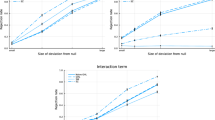Abstract
Two predominant computing methods for generalized linear mixed models (GLMMs) are linearization, e.g., pseudo-likelihood (PL), and integral approximation, e.g., Gauss–Hermite quadrature. The primary GLMM package in R, LME4, only uses integral approximation. The primary GLMM procedure in SAS®, PROC GLIMMIX, was originally developed using linearization, but integral approximation methods were added in the 2008 release. This presents a dilemma for GLMM users: Which method should one use, and why? Linearization methods are more versatile and able to handle both conditional and marginal GLMMs. Linearization can be implemented with REML-like variance component estimation, whereas quadrature is strictly maximum likelihood. However, GLMM software documentation and the literature on which it is based tend to focus on linearization’s limitations. Stroup (Generalized linear mixed models: modern concepts, methods and applications, CRC Press, Boca Raton, 2013) reiterates this theme in his GLMM textbook. As a result, “conventional wisdom” has arisen that integral approximation—quadrature when possible—is always best. Meanwhile, ongoing experience with GLMMs and research about their small sample behavior suggest that “conventional wisdom” circa 2013 is often not true. Above all, it is clear there is no one-size-fits-all best method. The purpose of this paper is to provide an updated look at what we now know about quadrature and PL and to offer some general operating principles for making an informed choice between the two. A series of simulation studies investigating distributions and designs representative of research in agricultural and related disciplines provide an overview of each method with respect to estimation accuracy, type I error control, and robustness (or lack thereof) to model misspecification.
Supplementary materials accompanying this paper appear online.


Similar content being viewed by others
References
Bolker, B.M., Brooks, M.E., Clark, C.J. Geange, S.M., Poulsen, J.R., Stevens, H.H, and White, J.S. (2009) Generalized linear mixed models: a practical guide for ecology and evolution. Trends in Ecology & Evolution. 24:3: 127–135.
Breslow, N. E., and Clayton, D. G. (1993). “Approximate Inference in Generalized Linear Mixed Models.” Journal of the American Statistical Association 88:9–25.
Breslow, N. E., and Lin, X. (1995). “Bias Correction in Generalised Linear Mixed Models with a Single Component of Dispersion.” Biometrika 81:81–91.
Claassen, E. A. (2014). A Reduced Bias Method of Estimating Variance Components on Generalized Linear Mixed Models. PhD Dissertation. Lincoln, NE: University of Nebraska.
Gbur, E.E., Stroup, W.W., McCarter, K.S., Durham, S., Young, L.J., Christman, M., West, M., and Kramer, M. (2012). Analysis of Generalized Linear Mixed Models in the Agricultural and Natural Resources Sciences. Madison, WI.: American Society of Agronomy, Soil Science Society of America, Crop Science Society of America.
Harville, D. A. (1977). “Maximum Likelihood Approaches to Variance Component Estimation and to Related Problems.” Journal of the American Statistical Association 72:320–338.Hilbe, J. M. (2014). Modeling Count Data. Cambridge: Cambridge University Press.
Molas, M. and Lesaffre, E. 2011. Hierarchical generalized linear models – the R package HGLMMM. Journal of Statistical Software. 39:13.
Murray, D. M., Varnell, S. P., and Blitstein, J. L. (2004). “Design and Analysis of Group-Randomized Trials: A Review of Recent Methodological Developments.” American Journal of Public Health 94:423–432.
Pinheiro, J. C., and Bates, D. M. (1995). “Approximations to the Log-Likelihood Function in the Nonlinear Mixed-Effects Model.” Journal of Computational and Graphical Statistics 4:12–35.
Pinheiro, J. C., and Chao, E. C. (2006). “Efficient Laplacian and Adaptive Gaussian Quadrature Algorithms for Multilevel Generalized Linear Mixed Models.” Journal of Computational and Graphical Statistics 15:58–81.
R Core Team (2013). R: A language and environment for statistical computing. R Foundation for Statistical Computing, Vienna, Austria. URL http://www.R-project.org/.
SAS Institute Inc. (2019) User’s Guide for SAS/STAT 14.3. Cary, NC: SAS Institute Inc. SAS/STAT 14.3. Cary, NC: SAS Institute Inc.
Schabenberer, O. and Stroup, W.W. W. (2008). Generalized Linear Mixed Models: Theory and Applications. Short Course, 2008 Joint Statistical Meetings.
Stroup, W.W. (2013) Generalized Linear Mixed Models: Modern Concepts, Methods and Applications. Boca Raton, FL: CRC Press.
Stroup, W.W. (2014) Rethinking the analysis of non-normal data in plant and soil science. Agronomy Journal 106:1–17.
Stroup, W.W. and Littell, R.C. (2002). “Impact of Variance Component Estimates on Fixed Effect Inference in Unbalanced Linear Mixed Models. Conference on Applied Statistics in Agriculture. https://doi.org/10.4148/2475-7772.1198
Stroup, W., Milliken, G.A., Claassen, E.A. and Wolfinger, R.D. (2018) SAS for Mixed Models: Basic Concepts and Applications. Cary, NC: SAS Institute Inc.
Wolfinger, R. D., and O’Connell, M. A. (1993). “Generalized Linear Mixed Models: A Pseudo-likelihood Approach.” Journal of Statistical Computation and Simulation 48:233–243.
Author information
Authors and Affiliations
Corresponding author
Additional information
Publisher's Note
Springer Nature remains neutral with regard to jurisdictional claims in published maps and institutional affiliations.
Electronic supplementary material
Below is the link to the electronic supplementary material.
Rights and permissions
About this article
Cite this article
Stroup, W., Claassen, E. Pseudo-Likelihood or Quadrature? What We Thought We Knew, What We Think We Know, and What We Are Still Trying to Figure Out. JABES 25, 639–656 (2020). https://doi.org/10.1007/s13253-020-00402-6
Received:
Accepted:
Published:
Issue Date:
DOI: https://doi.org/10.1007/s13253-020-00402-6




